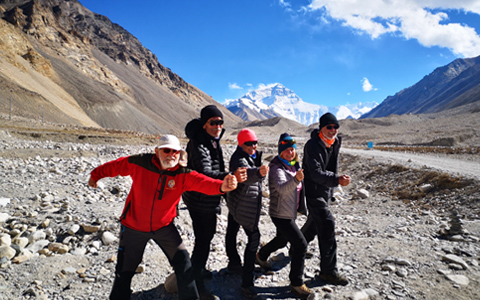The Qinghai Tibet Train offers a truly unique journey for anyone traveling to Tibet. As it winds along the world-famous Qinghai-Tibet Railway, you will be treated to breathtaking landscapes that you won’t find anywhere else. Plus, the train ensures a comfortable travel experience with cozy sleeper berths and complete facilities.
Whether you're a seasoned traveler or taking your first adventure to Tibet, the Qinghai Tibet Train promises an unforgettable experience. Here are eight reasons why this train route is so extraordinary.
1. Qinghai Tibet Train is the First Train Route to Tibet
When the railway to Tibet from Qinghai Province was planned, many said that it would be impossible to run a train over the mountains to the Tibetan Plateau. But when the Qinghai-Tibet Railway opened in 2006, it broke all the normal rules of railways, becoming an engineering marvel unmatched anywhere else in the world.
As the first train route to connect Tibet with the rest of China, the Qinghai Tibet Train revolutionized travel to the region. Starting in Xining, it journeys all the way to Lhasa, making it much easier for tourists to reach the heart of Tibet. For international travelers, the train has also made traveling to Tibet more convenient than ever.
Join our Beijing Tibet tour with Tibet train experience
2. Qinghai Tibet Train Runs on the World’s Highest Railway
The Qinghai Tibet Railway is the highest railway in the world, running at an average altitude of around 4,500 meters above sea level. It’s highest point, in the Tanggula Mountains, reaches 5,072 meters. This is more than 200 meters higher than the previous record holder, the Peruvian Railway in the Andes.
As the world’s highest railway, nearly 960 kilometers of track lie above 4,000 meters. The Tanggula Station, at 5,068 meters, is the highest railway station on the planet. The tracks rise up from Golmud, crossing the Kunlun and Tanggula Mountains, before entering Tibet Autonomous Region and continuing to Lhasa, which sits at 3,656 meters.
 Tibet train runs on the world's highest rail rack, Qinghai Tibet Railway.
Tibet train runs on the world's highest rail rack, Qinghai Tibet Railway.3. Qinghai Tibet Train Offers the Longest Plateau Train Journey
Spanning a distance of 1,956 kilometers (about 1,200 miles), the Qinghai Tibet Railway offers the longest plateau train journey in the world. The railway has a total of 85 stations, with major stops including Delingha (517 kilometers from Xining), Golmud (814 kilometers from Xining), and Nagchu (1650 kilometers form Xining).
In addition, there is an extension of the Qinghai-Tibet Railway from Lhasa to Shigatse, which fully opened in 2014. If you are going to visit Mount Everest Base Camp in western region of Tibet, you can also take advantage of this 253-kilometers train line as part of the journey.
 Lhasa to Shigatse train route is an extension of Qinghai-Tibet Railway.
Lhasa to Shigatse train route is an extension of Qinghai-Tibet Railway.4. The Scenery along Qinghai Tibet Train is as Spectacular as Tibet Itself
The Qinghai Tibet Train is renowned for its outstanding scenery, which is unrivalled in the world. When taking the train, you can appreciate the spectacular landscape of northern Tibet as the train pass through mountain ranges and vast plains.
After the train rises up to the plateau from Golmud, it will cross the Kunlun Mountains, some of the most beautiful mountain landscapes in northwest China. It then heads across the Kekexili National Nature Reserve, one of the most stunning and remote areas of the plateau. This vast prairie is home to a variety of wild animals, including the rare Tibetan antelope, wild yaks, and the wild kiang.
 The Qinghai Tibet Train runs through Tanggula Mountain range.
The Qinghai Tibet Train runs through Tanggula Mountain range.As the train passes over the Tanggula Mountains, you will be treated to amazing views of this huge range of the Transhimalaya. The mountains soon give way to the expansive Changtang Grasslands, which are home to many Tibetan nomads. Heading north, the train passes through the famous Nyenchen Tanglha Mountains, which stretch all the way to Lhasa.
Enjoy breathtaking railway views by taking our China Tibet train tour
5. There are 8 Routes for the Qinghai Tibet Train, with the Shortest Starting from Xining
In fact, there are currently eight different routes for the Qinghai Tibet Train. You can start your Tibet train journey from Beijing, Shanghai, Guangzhou, Chengdu, Chongqing, Xi’an and Lanzhou, and of course, Xining. These routes vary in distance, but the Xining to Lhasa route is the shortest, covering 1956 kilometers and only taking 21 hours to complete the journey.
Besides, since all trains to Tibet will pass and stop in Xining, you can first fly to Xining and then take the train to Lhasa, to cut down the overall travel time. Direct flights to Xining are available from many cities like Beijing, Shanghai, Guangzhou, etc. And from Xining, you have more chances to get a train ticket as well.
 There are totally eight train routes to Lhasa.
There are totally eight train routes to Lhasa.6. Oxygen Supply is Available on Qinghai Tibet Train
One of the unique features of the Qinghai Tibet train is the oxygen supply onboard. All trains to Tibet are equipped with two separate oxygen systems: one for pumping oxygen direct into the carriages, and another of personal use.
After departing from Golmud, the oxygen system is activated, and oxygen is piped into the carriages, to increase the oxygen content of the normal air at higher altitudes. This helps prevent altitude sickness, which can affect almost all passengers as the train climbs to over 4,000 meters.
However, some passengers may still suffer from altitude sickness. To assist, personal oxygen outlets are available throughout the train, including in all cars, sleeper cabins, hart seat carriages, and corridors. Oxygen tubes for personal use are provided free of charge, and you can simply ask the train staff for one if needed.
 Oxygen outlet is provided for individual passengers to ensure your safety onboard Tibet Trains.
Oxygen outlet is provided for individual passengers to ensure your safety onboard Tibet Trains.7. One Can Enjoy Comfortable Soft Sleeper Berths on Qinghai Tibet Train
The trains to Tibet offer three classes of tickets: hard seat, hard sleeper berth, and soft sleeper berth. Among them, the soft sleeper berths are the most popular choice for travelers, as they provide the most comfortable experience onboard.
Since each soft sleeper cabin has only four berths over two levels (compared to six in the hard sleeper cabin), the berths are more spacious, with ample length and headroom for both upper and lower berths. The soft beds also ensure you arrive refreshed and ready to explore Tibetan Plateau when you reach Lhasa.
 Soft sleepers on Tibet trains offer the most comfortable experience.
Soft sleepers on Tibet trains offer the most comfortable experience.The soft sleeper berths also offer more privacy, as each cabin has a lockable door. Besides, each soft sleeper berth is equipped with an independent reading light, and an oxygen outlet for personal use.
Our tour includes a soft sleeper ticket from Xining to Lhasa.
8. Modern Facilities is Provided on the Qinghai Tibet Train
The Qinghai Tibet Train doesn’t just offer stunning views and comfortable accommodations - it also provides a variety of modern facilities to enhance your train journey.
There is a dinning car that can seat around 40-50 passengers a time. You can enjoy breakfast, lunch, and dinner, as well as drinks and snacks at other times, with a wide range of freshly-cooked Tibetan and Chinese dishes. The large windows allow you to enjoy the scenery while savoring your meal.
Each passenger car is equipped with toilet and washing facilities. The toilets are located at both ends of the car, with one side featuring a western-style toilet and the other Asian squat toilet. There are also washing facilities at the ends of the cars, with three sinks offering hot and cold water, along with soap dispensers.
Besides, hot water for coffee, tea, and pot snacks is available at both ends of each car, through a wall-dispenser, and is always boiling hot. This makes it easier to bring your own tea or coffee, and prepare snacks like instant noodles and packet meals.
 Tibet train is provided with drinking water dispensers onboard.
Tibet train is provided with drinking water dispensers onboard.The trains to Tibet also features large windows in the corridors of both soft and hard sleeper cabin cars, as well as fold-down seats so that you can sit and watch the stunning Tibetan plateau landscape pass by outside. Overall, the experience of traveling by train to Tibet is one of comfort, pleasure, and leisure, and is unbeatable anywhere else in the world for its views and facilities.
Conclusion
For many tourists planning a trip to Tibet, the Qinghai Tibet Train is more than just a mode of transportation. With spectacular views, comfortable accommodations and complete facilities, the train journey to Tibet is once-in-a-lifetime experience for any traveler seeking to explore the region. If you are planning a Tibet train journey, please feel free to contact us for any inquiries or trip ideas.


























 Tibet train runs on the world's highest rail rack, Qinghai Tibet Railway.
Tibet train runs on the world's highest rail rack, Qinghai Tibet Railway. Lhasa to Shigatse train route is an extension of Qinghai-Tibet Railway.
Lhasa to Shigatse train route is an extension of Qinghai-Tibet Railway. The Qinghai Tibet Train runs through Tanggula Mountain range.
The Qinghai Tibet Train runs through Tanggula Mountain range. There are totally eight train routes to Lhasa.
There are totally eight train routes to Lhasa. Oxygen outlet is provided for individual passengers to ensure your safety onboard Tibet Trains.
Oxygen outlet is provided for individual passengers to ensure your safety onboard Tibet Trains. Soft sleepers on Tibet trains offer the most comfortable experience.
Soft sleepers on Tibet trains offer the most comfortable experience. Tibet train is provided with drinking water dispensers onboard.
Tibet train is provided with drinking water dispensers onboard.








Ask a Quick Question